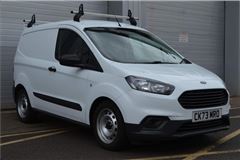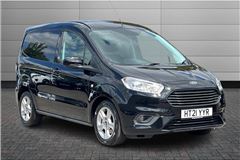Ford E-Transit Courier Review 2025
Ford E-Transit Courier At A Glance
Say hello to Ford’s dinkiest electric van. What you’re looking at is the Ford E-Transit Courier, which underneath is actually more car than commercial vehicle. It's also plenty big inside despite being the runt of the Ford Pro litter.
As is the petrol and diesel-powered version of the Ford Transit Courier, it's partly related to the Ford Puma, rather than being Fiesta-derived like the previous-generation model. That means it's longer but only by 200mm. You might think this isn't going to increase it's carrying capacity by all that much but you'd be wrong. Better packaging this time around — particularly with the positioning of the rear suspension — generates a whopping 25% increase in load space.
Speaking of which, you get the same amount of load space in the Ford E-Transit Courer as you do in the back of the combustion-engined versions, which amounts to 2.9 cubic metres. The electric version also manages slightly heavier payloads as standard at nearly 700kg.
What the Ford E-Transit Courier isn't is a van to be covering great distances in too frequently — its 43kWh battery pack makes for a WLTP Combined cycle driving range of 186 miles. Those official EV range figures are always hard to replicate — we reckon somewhere around 140 miles in optimum conditions is likely, minus a decent chunk in cold conditions and when clocking a lot of motorway and dual carriageway mileage.
For the kind of operators vans like these are aimed at, including last-mile delivery drivers and locally-operating sole traders, these kind of numbers are likely to prove more than enough.
You won’t have to wait around for long should you ever want to go further in one sitting, with 100kW DC rapid charging capability making a 10%-80% charge possible in 23 minutes, providing you hooked up to a fast enough charger (there are still quite a few 50kW units dotted around) and conditions are just right. For a van, this is decent, but nothing out of the ordinary — the Citroen e-Berlingo manages the same, although it is 25kW better than the Mercedes eCitan.
You’d be hard-pressed to tell the difference between the electric E-Transit Courier and the petrol and diesel versions from the outside, with only slightly different headlights and grille designs separating the them. While aesthetics are unlikely to be a deal maker or breaker for most commercial vehicle buyers or fleet managers, the little Ford is a handsome thing, as far as vans go.
As you'd probably expect, it's more expensive than a petrol or diesel-powered Transit Courier, with the Trend-trimmed version coming in at £28,806.83 excluding VAT, while the Limited costs £29,806.83. Compare those to non-electric versions for the Ford Transit Courier, which range from £21k to £26k in Trend and £23k to £28,500 in Limited. You also can't have the E-Transit Courer in the entry-level Leader trim, which starts at just £18,000 in combustion-engined guide. It's also possible to buy some versions of the larger, combustion-only Ford Transit Connect for less than an E-Transit Courier.
Those prices are similar to that of the (admittedly slightly larger) Citroen e-Berlingo and a bit cheaper than the Mercedes eCitan. For many, whether individual operators or fleet managers, the potential savings in terms of running costs will eventually more than outweigh the increased outlay.
Away from the pure numbers, electric power makes the Ford E-Transit Courier more relaxing to drive than the combustion-engined equivalents, lowering the potential stress levels during a busy day's work on the move.
Driving the Ford E-Transit Courier
Performance isn’t exactly startling for the Ford E-Transit Courier, with a single, front-mounted electric motor generating 135PS and 290Nm of torque. Our test van had 240kg ballast in the load bay to simulate a light-to-moderate load, so it might feel a little more sprightly when empty, but don't expect this to be a rocket ship.
As we see with many EVs, the E-Transit Courier is brisk off the mark, so nipping out into that tight gap on a roundabout is going to be easy enough. At the same time, the throttle response isn't overly sharp, making the Ford easy to drive. Although it is possible for an EV to deliver all its torque instantaneously, you might not want that when carrying a delicate load.
Generally, the E-Transit Courier is relaxing and effortless to drive, reminding you that electric power really does make a lot of sense for a van. There's also a one-pedal driving mode, which sees the van slow dramatically when you lift off the throttle pedal, meaning you'll rarely need to touch the brakes.
The E-Transit Courier takes corners confidently with minimal body roll and the steering has a well-judged weight to it. At motorway speeds, wind and road noise are reasonably well-suppressed, which is no mean feat when there's no engine noise to drown either out.
Our test example rode well with its ballast on board — we're yet to try one either empty or fully loaded — settling well after negotiating bumpier bits of asphalt. Generally, it's very car-like to drive, both in its composed handling and its compact footprint. Being shorter than a Ford Focus makes for easy manoeurvring.
Ford E-Transit Courier interior
For a van, the Ford E-Transit Courier has a reasonably fancy interior in terms of design, albeit clad in tough-feeling but well-finished materials that should stand up to years of use and abuse.
There’s a minimalistic dashboard dominated by one massive panel housing two 12.0-inch screens, the left one forming the instrument cluster and the other one being a touchscreen infotainment system. The latter runs on Ford’s SYNC4 software and although its in-built navigation works just fine, it’s still not quite as good as Google Maps. Should you prefer to use that, Android Auto and Apply CarPlay connectivity are included as standard.
While the infotainment screen is reasonably responsive to touch, switching between different menus and features usually results in a bit of lag while the system has a think about what's been requested of it.
The minimalistic approach to the interior design might have gone a bit too far in some regards. There are no physical controls for the climate functions, so you’ll have no choice but to use the touchscreen for those, which is easier said than done on the move, because they're small icons.
The steering wheel is referred to as a 'squircle' because it has flat-ish sections at the bottom and the top. This isn't an attempt to appear sporty — it's all about providing more knee room and a good view of the instrument cluster. On both fronts the 'squircle' (nope, still hate that word) works as advertised.
There are wide and deep door bins on each side of the passenger cabin and a handy storage area under the infotainment screen that includes a wireless charging pad on Limited models, optional on Trend versions at a cost of £72.02. You also get storage area between the front seats with two inserts that can switch places or be removed entirely. One is a storage tray, and the other a double cup-holder. There's also a shallow storage area on the top of the dashboard.
The passenger seat lacks any kind of adjustment as standard, presumably because of its folding mechanism, and feels quite upright in its fixed position. Four-way adjustment is a £90 extra we'd recommend.
The load space optionally features LED lighting (at a cost of £50) and has space for two Euro pallets, plus a load-through bulkhead allowing narrower items up to 2.6 metres in length to be carried once a panel is removed and the front passenger seat is folded.
The Limited has a maximum payload of 682kg, while for the Trend, it's 698kg. These are the highest figures across the range in terms of standard Transit Couriers, but neither model is available with the Gross Vehicle Mass Upgrade Kit, which beefs up the suspension, which is optional across the rest of the range. With this fitted, some versions can carry nearly 850kg.
At 750kg, the towing capacity of the E-Transit Courier is noticeably lower than that of the petrol and diesel models, which range from 1000 to 1100kg.
With no engine under the bonnet, the Ford E-Transit Courier has the bonus of a 44-litre frunk instead, so you can store the charging cable without having it take up space in the back.







![2023 Ford Transit Courier 1.0 EcoBoost Limited Van [6 Speed]](http://images.honestjohn.co.uk/imagecache/url/crop/150x100/https/cdn.uk.prod.group-mobility-trader.com/images/cas/19d2a8874b02b0e7a0bb6b916f62f310/e98ce2029305e98e330f7473b8ccf176.jpg)

 Much larger load space than its predecessor. Smooth electric drive system makes it more relaxing than the petrol and diesel versions. Surprisingly pleasant interior.
Much larger load space than its predecessor. Smooth electric drive system makes it more relaxing than the petrol and diesel versions. Surprisingly pleasant interior.
 Not hugely powerful. Annoying infotainment-based climate controls. Costs more than many versions of the larger Transit Connect.
Not hugely powerful. Annoying infotainment-based climate controls. Costs more than many versions of the larger Transit Connect.


